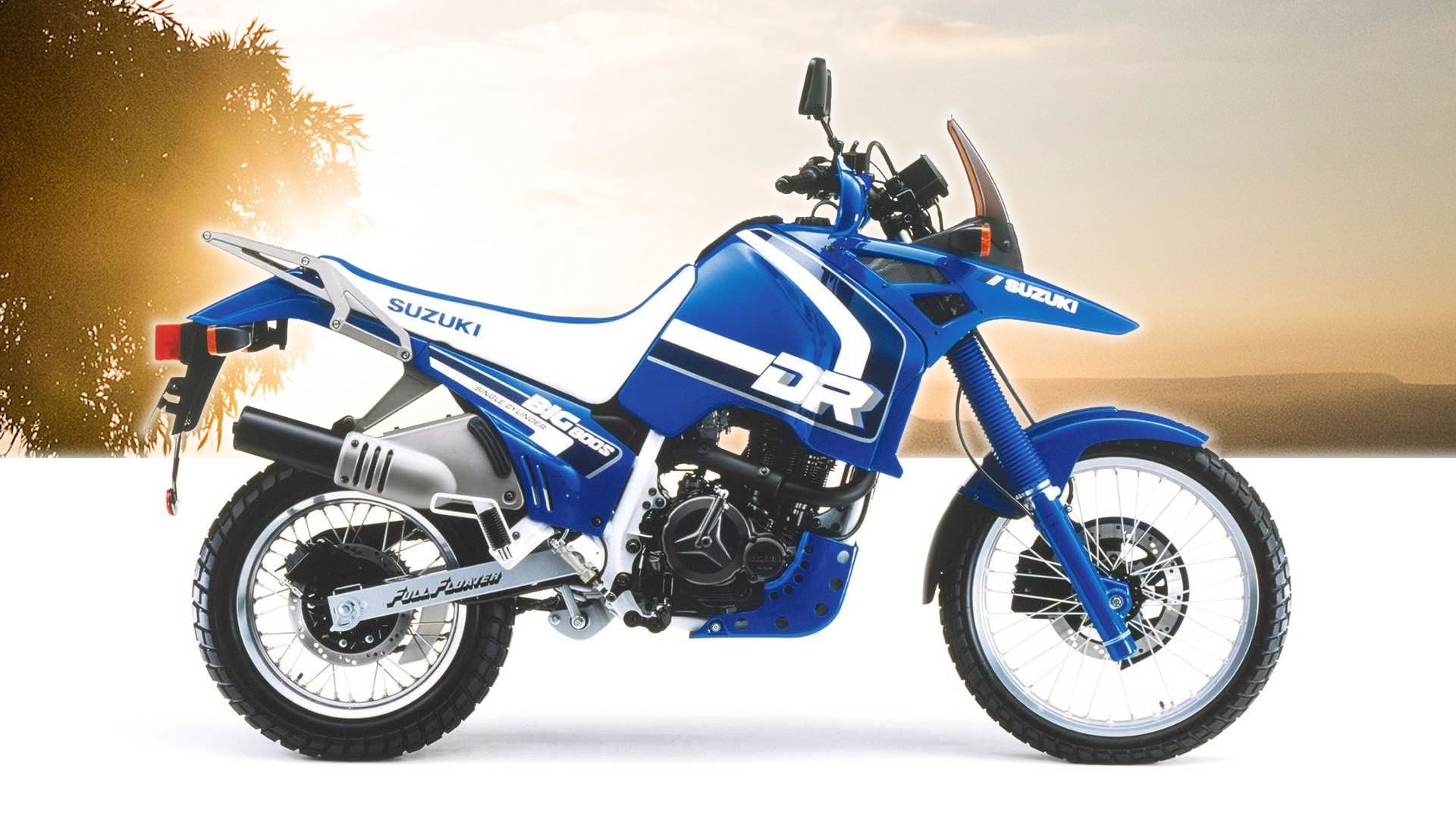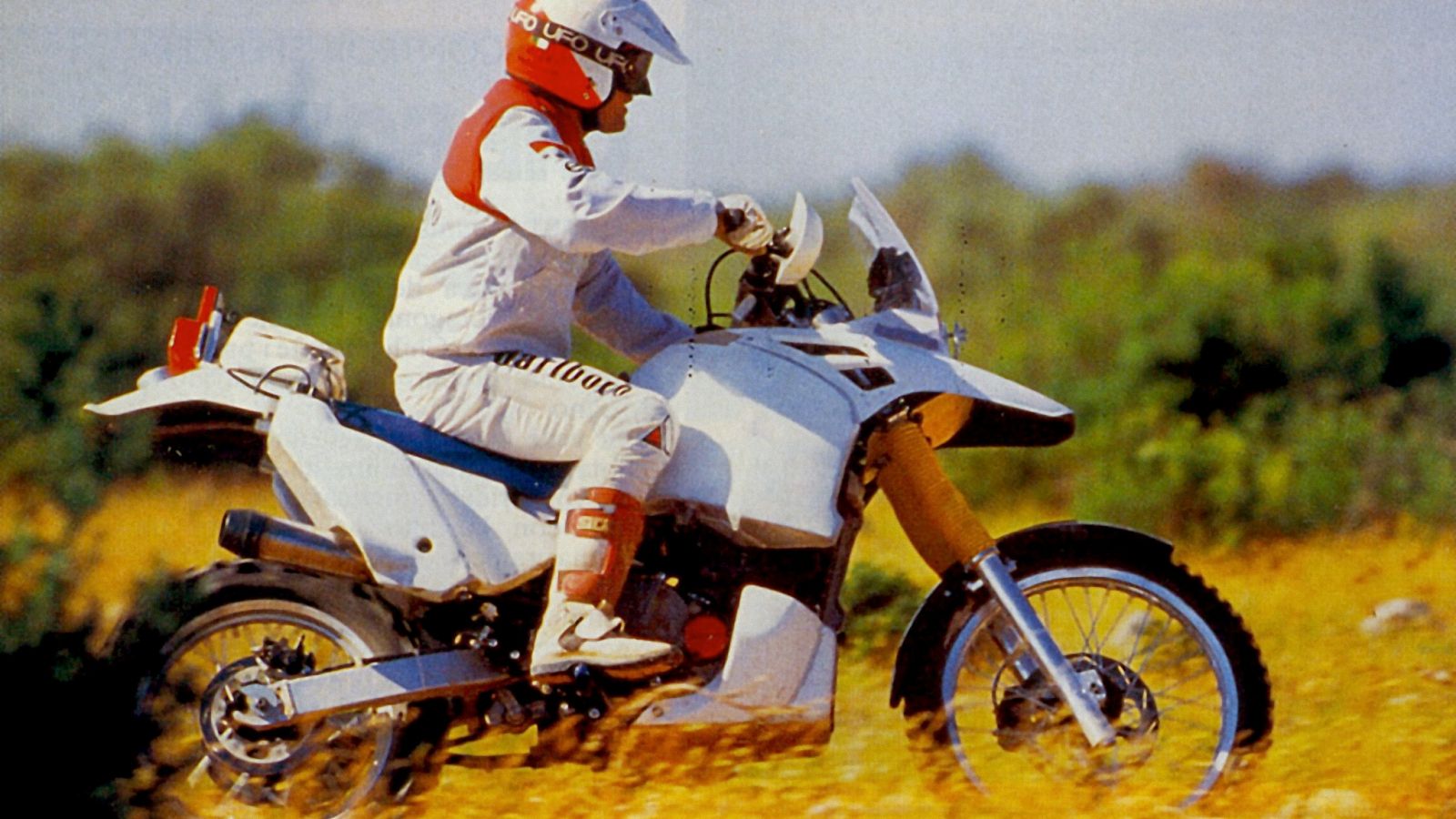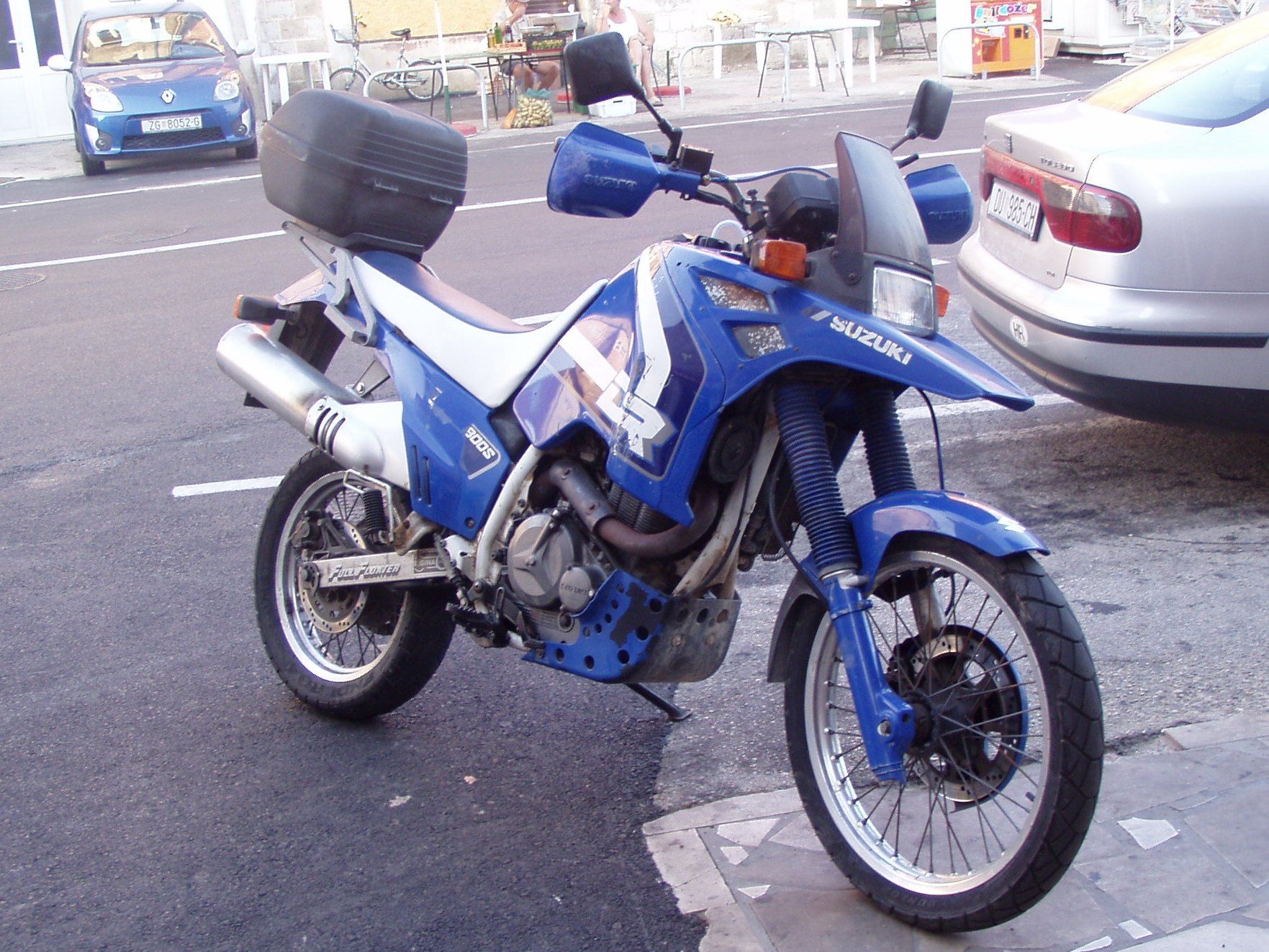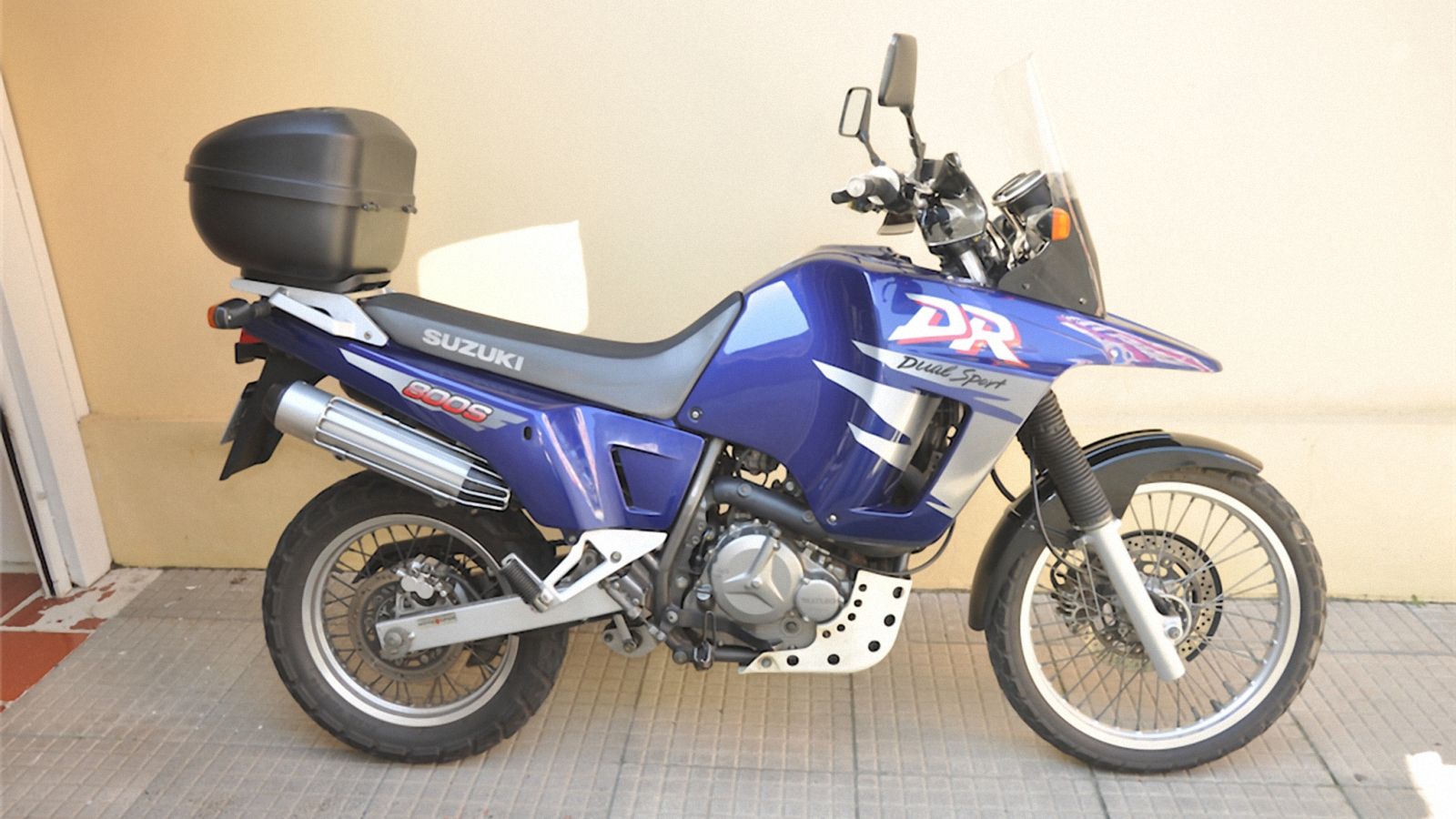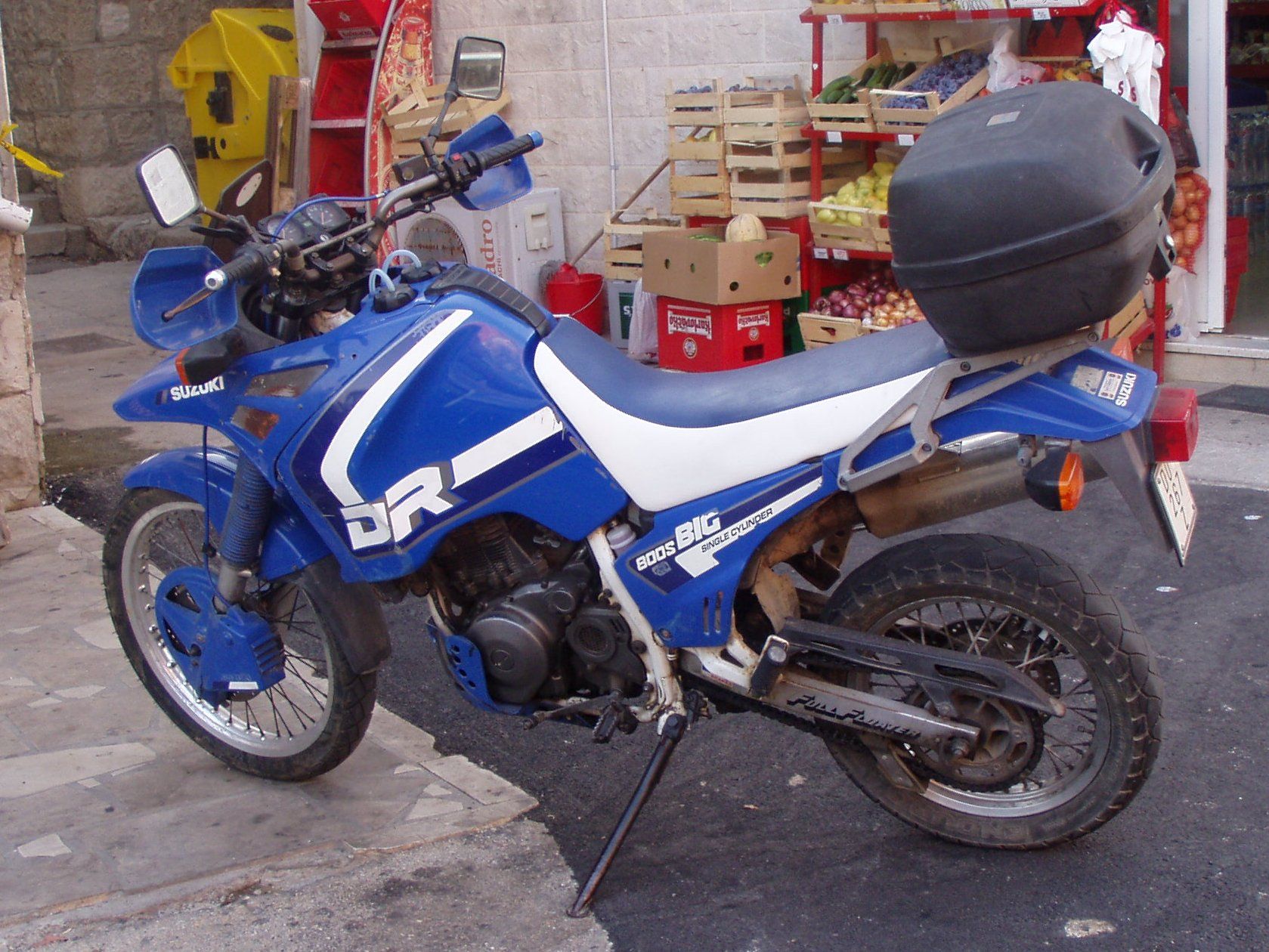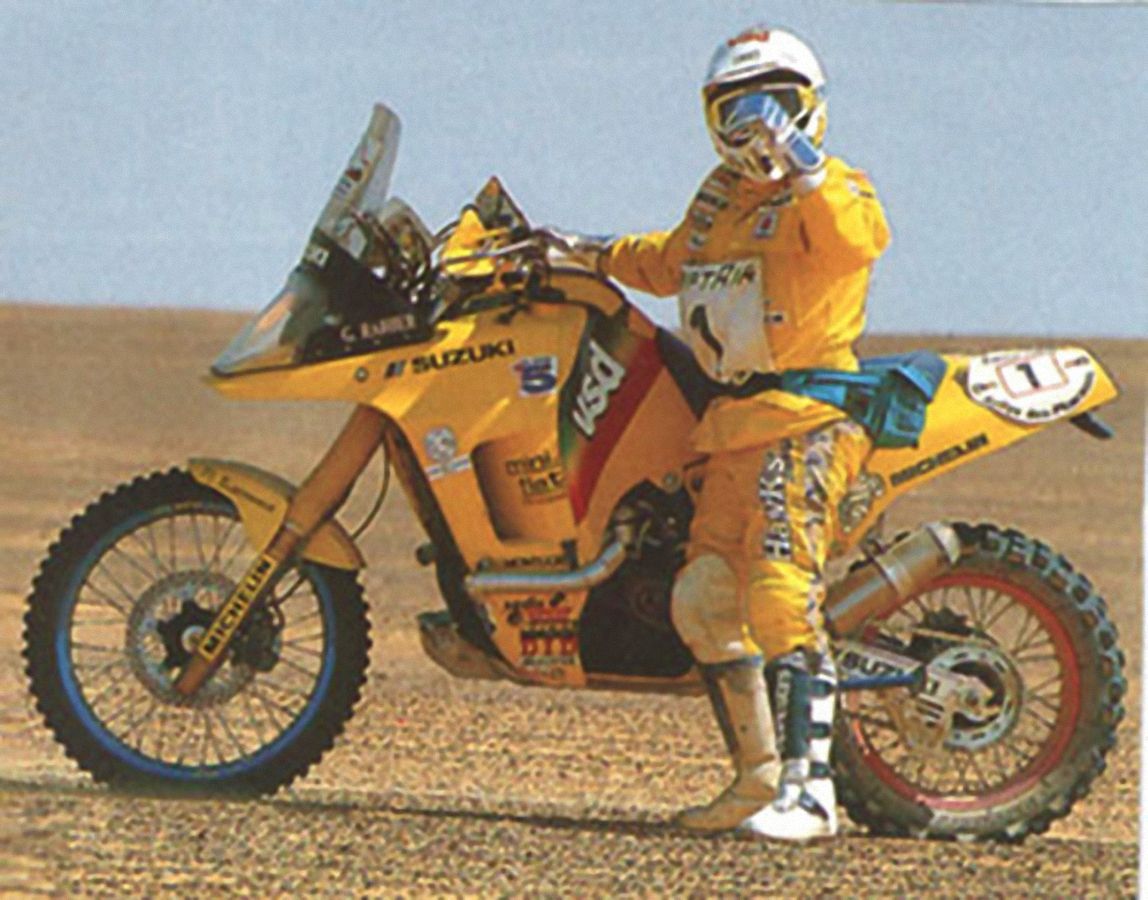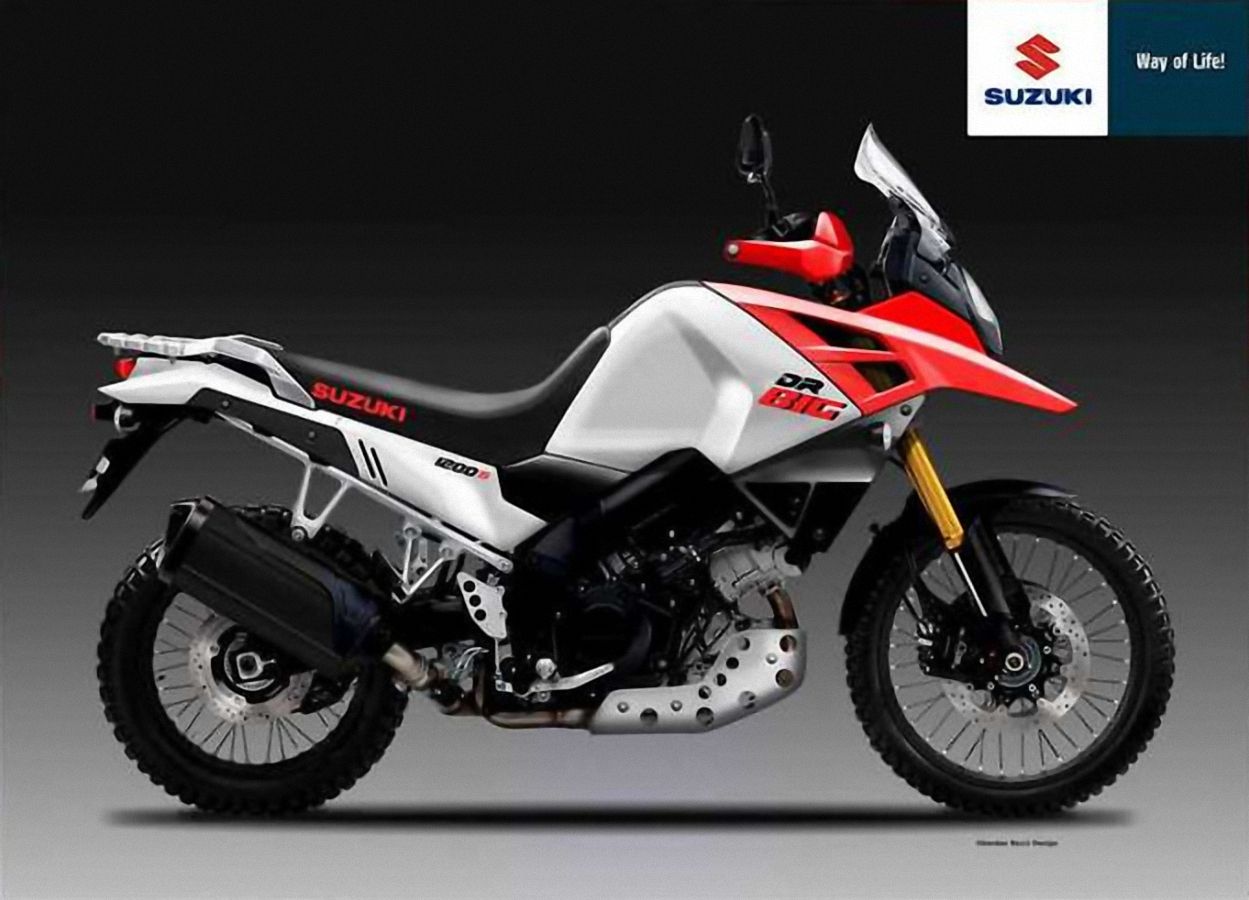Suzuki arguably launched the adventure-bike genre all the way back in 1988 with its DR750S “Big” model. Also called the “Desert Express,” it delivered long range off-road performance and comfort superior to that which you could expect from the enduro-style bikes of the day. The factory boosted the displacement ahead of the 1990 model year to set up a decade-long reign as the grand-daddy of dual-sports.
1988 - 1999 Suzuki DR Big
- Make: Array
- Model: 1988 - 1999 Suzuki DR Big
- Segment: Array
- Engine/Motor: single cylinder
- [do not use] Vehicle Model: Array
Suzuki DR Big Design
The genetic markers are plainly visible on this machine, and it's easy to see why it's credited with launching the modern adv-bike sector since all the design high points are well represented. It starts out with double front-fling containment in the form of a slightly cut back front fender and a narrow bird's beak for secondary coverage. A rally-style windscreen tops the front fairing, though in truth, it does more to protect the instruments than it actually does for the rider.
In 1988 we were still around a decade shy of the first production usd front forks, and the ridiculously long bellow-gaiters speak to a generous suspension stroke the likes of which is normally only seen in the most serious MotoCross/SuperCross machines. The beak flows into a rather narrow fairing by modern standards that continues across the 6.3-gallon, camel-hump fuel tank. Originally, the knee pockets were considered insufficient for taller riders, but a complete tank redesign ahead of the '91 model year rectified that issue.
The flyline tumbles down the backside of the tank to a deep swale that parks the pilot's booty at a lofty 34.5 inches off the ground. Yeah, that's kinda' on the tall side of the spectrum, but that's the price you pay for the 9.4 inches of ground clearance on the '88 and '89 model that was dropped to 9.1 inches from '90 on up.
Fold-up footpegs and small J.C. handles let you share the fun with a friend or bungee down some cargo, and in the modern style, the taillight is recessed at the tip of the tail with turn signals to complete the street-legal package and a short mudguard/plateholder to finish off the gear in the rear. Overall, it's very easy to see the similarities between this machine and the modern ones that bear names such as V-Strom, Tiger, Versys, and Multistrada.
Suzuki DR Big Chassis
Even though there was an engine change that made for a name change from the DR750S to the DR800S, the rest of the machine stayed largely the same, and that includes the bones, except for a shift from 5.35 inches of trail to 5.31 inches of trail in '91. Welded steel tubing made up the frame with a yoke-style swingarm to articulate the rear wheel and a monoshock to control it. The 43 mm, telescopic front forks were air-damped, and they delivered 9.4 inches of travel across the entire family with 8.7 inches of travel and adjustable spring preload out back.
A set of the ever-popular-with-off-road-riders laced wheels rounded out the rolling chassis in an asymmetrical layout that led off with a 90/90-21 hoop and finished with a 130/80-17. Stealth-knobbies made the connection to the ground with a compromise between on- and off-road considerations, and they were particularly good on soft terrain such as sand or loose dirt.
Across the range, a single twin-piston caliper bit a 300 mm front disc and a single-piston anchor grabbed a 250 mm disc out back. What about ABS or linked brakes? Forget about it, way too early in the game for that kind of fandanglery.
|
DR 800 S Frame: |
Steel |
|
Front suspension, travel: |
Telescopic fork 43 mm, 9.4 in (240 mm) |
|
Rear suspension, travel: |
Swingarm with mono-shock, spring pre-load full adjustable, 8.7 in (220 mm) |
|
Trail: |
|
|
└ 1990: |
5.35 in (136 mm) |
|
└ 1991-1997: |
5.31 in (135 mm ) |
|
Front tire size: |
90/90-21 54S |
|
Rear tire size: |
130/80-17 65S |
|
Front brake: |
Single disc, 300 mm, 2-piston caliper |
|
Rear brake: |
Single disc, 250 mm, 1-piston caliper |
Suzuki DR Big Drivetrain
The first-run machines from the '88 and '89 model years rocked the SR 41 B powerplant that displaced a total of 727 cc in a four-stroke thumper format. It generated 52 horsepower at 6,600 rpm and 42.7 pound-feet of torque at 5,500 and was both air- and oil-cooled.
In 1990, Suzuki released the DR800S with the SR 42 B to replace the original after it punched the bore out to boost displacement up to 779 cc. Naturally, this brought with it a power increase up to 54 ponies and 45.7 pound o' grunt, and the new engine boasted water-cooling for greater thermal stability.
The very next year, the factory updated the engine again with the SR 43 B, and it's unclear to me why they did so since the output figures and all other critical metrics are identical with the previous model. Whatever the reason, that final mill pushed the line through production in '96 with the official line termination occurring in '97, though you could still find limited new stock up till the millennium.
Induction control fell to a pair of BST33SS Mikuni carburetors. A five-speed, constant-mesh transmixxer crunched the ratios with a wet clutch to couple it to the engine, and it sent the power to the rear wheel via chain drive. Top speed on the final engine was clocked at 105 mph (unofficial), but seriously, that's way too fast on dirt and way too fast for comfort for hybrid tires on paved roads.
|
DR 800 S Engine: |
Air-cooled 4-stroke Single cylinder |
|
Bore & Stroke: |
105.0 x 90.0 mm (4.134 x 3.543 in) |
|
Displacement: |
779 cc (47.5 cu in) |
|
Compression ratio: |
9.5:1 |
|
Valve train: |
Chain driven OHC, 4 valves |
|
Max. power: |
54 hp (39.7 kW) @ 6,600 rpm |
|
Max. torque: |
45.7 lb-ft (62 Nm) @ 5,400 rpm |
|
Carburetion System: |
2x Mikuni BST33SS |
|
└ 1990: |
45BXX |
|
└ 1991-1997: |
31DX |
|
Clutch: |
Wet, multi-plate |
|
Transmission: |
5-speed |
|
Final drive: |
Chain |
|
Primary reduction: |
1.848 (61/33) |
|
Final reduction: |
|
|
└ 1990: |
3.200 (48/15) |
|
└ 1991-1997: |
3.133 (47/15) |
|
Gear ratio: |
1st: 2.461 (32/13), 2nd: 1.578 (30/19), 3rd: 1.200 (24/20), 4th: 0.956 (22/23), 5th: 0.800 (20/25) |
He Said
“It's easy to see why so many claim this is the bike that started it all. It has the look, and the distinctive profile, and it was definitely hot stuff when it was a new item. Credit where it's due, Suzuki definitely had a stroke of genius when it cooked up this ride, and it definitely played a role in the design of the V-Strom family.”
She Said
My wife and fellow motorcycle writer, Allyn Hinton, says, “The Suzuki DR Big was the production version of the bike ridden by Gaston Rahier in the Paris-Dakar rally in the late '80s, After BMW refused to upgrade his R100GS, he jumped ship to Suzuki and did a big in-your-face by winning the next year on the DR. It's no surprise that the DR750 and DR 800 were capable off-road bikes considering how rugged the rally terrain is and how well it performed at the hands of the man who was an iconic figure in rally racing. Rahier's Suzuki DR Big was featured at EICMA 2014 as a tribute to him and his contribution to the sport.”
Suzuki DR 800 S Big Specifications
|
Engine & Drivetrain: |
|
|
Engine: |
Air-cooled 4-stroke Single cylinder |
|
Bore & Stroke: |
105.0 x 90.0 mm (4.134 x 3.543 in) |
|
Displacement: |
779 cc (47.5 cu in) |
|
Compression ratio: |
9.5:1 |
|
Valve train: |
Chain driven OHC, 4 valves |
|
Max. power: |
54 hp (39.7 kW) @ 6,600 rpm |
|
Max. torque: |
45.7 lb-ft (62 Nm) @ 5,400 rpm |
|
Carburetion System: |
2x Mikuni BST33SS |
|
└ 1990: |
45BXX |
|
└ 1991-1997: |
31DX |
|
Clutch: |
Wet, multi-plate |
|
Transmission: |
5-speed |
|
Final drive: |
Chain |
|
Primary reduction: |
1.848 (61/33) |
|
Final reduction: |
|
|
└ 1990: |
3.200 (48/15) |
|
└ 1991-1997: |
3.133 (47/15) |
|
Gear ratio: |
1st: 2.461 (32/13), 2nd: 1.578 (30/19), 3rd: 1.200 (24/20), 4th: 0.956 (22/23), 5th: 0.800 (20/25) |
|
Chassis: |
|
|
Frame: |
Steel |
|
Front suspension, travel: |
Telescopic fork 43 mm, 9.4 in (240 mm) |
|
Rear suspension, travel: |
Swingarm with mono-shock, spring pre-load full adjustable, 8.7 in (220 mm) |
|
Trail: |
|
|
└ 1990: |
5.35 in (136 mm) |
|
└ 1991-1997: |
5.31 in (135 mm ) |
|
Front tire size: |
90/90-21 54S |
|
Rear tire size: |
130/80-17 65S |
|
Front brake: |
Single disc, 300 mm, 2-piston caliper |
|
Rear brake: |
Single disc, 250 mm, 1-piston caliper |
|
Dimensions & Capacities: |
|
|
Overall length: |
|
|
└ 1990: |
88.8 in (2,255 mm) |
|
└ 1991-1997: |
87.8 in (2,230 mm) |
|
Overall width: |
|
|
└ 1990: |
37.2 in (945 mm) |
|
└ 1991-1997: |
34.1 in (865 mm) |
|
Overall height : |
|
|
└ 1990: |
51.0 in (1,295 mm) |
|
└ 1991-1997: |
52.2 in (1,325 mm) |
|
Seat height: |
|
|
└ 1990: |
35.0 in (890 mm) |
|
└ 1991-1997: |
34.5 in (876 mm) |
|
Wheelbase: |
|
|
└ 1990: |
59.4 in (1,510 mm) |
|
└ 1991-1997: |
59.8 in (1,520 mm) |
|
Ground clearance: |
|
|
└ 1990: |
9.3 in (235 mm) |
|
└ 1991-1997: |
9.1 in (230 mm) |
|
Dry weight: |
|
|
└ 1990: |
408 lbs (185 kg) |
|
└ 1991-1997: |
428 lbs (194 kg) |
|
Fuel capacity: |
|
|
└ 1990: |
29 l / 7.7 gal (incl. Reserve – 7.0 l) |
|
└ 1991-1997: |
6.3 gal (24 l) (incl. Reserve – 5.5 l) |
|
0 to 62 mph: |
5.6 sec |
|
Top speed: |
105 mph (170 km/h ) |
|
Fuel economy: |
38,5 mpg (6.19 l / 100 km) |
|
Electrical: |
|
|
Ignition: |
CDI |
|
Alternator: |
Three-phase generator |
|
Battery capacity: |
12V-12Ah |
Further Reading
Suzuki V-Strom 1000 & 1000XT
|
|
center> |
See our review of the Suzuki V-Strom 1000 & 1000XT.
Triumph Tiger 1200 XCa
|
|
center> |
See our review of the Triumph Tiger 1200 Xca.
Kawasaki Versys 1000 SE LT+
|
|
center> |
See our review of the Kawasaki Versys 1000 SE LT+.
Ducati Multistrada 950 / 950S
|
|
center> |
See our review of the Ducati Multistrada 950 / 950 S.
Suzuki
Read more Suzuki news.


